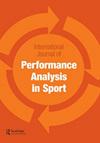Comparison of different models of Wʹ balance in high-level road cycling races
IF 1.6
4区 教育学
Q1 Health Professions
International Journal of Performance Analysis in Sport
Pub Date : 2022-09-03
DOI:10.1080/24748668.2023.2176100
引用次数: 0
Abstract
ABSTRACT This study aimed to compare different models of Wʹ balance (Wʹbal) during road cycling races. These models allow tracking of the depletion and reconstitution of energy reserves during intermittent exercises. Fifteen high-level cyclists shared a year of data, including the power output and GPS records. They then selected a race during which they were in very good condition, and where they reached a maximum level of exhaustion in the final phase. Based on their seasonal data, their critical power and Wʹ were calculated and incorporated into the integral and differential models of Skiba and Bartram model. Wʹbal was calculated throughout the races and normalised to Wʹ. The integral, differential, and Bartram models predicted a mean Wʹbal of 41 ± 27%, 67 ± 17%, and 82 ± 9%, a minimum Wʹbal of −21 ± 28%, −3 ± 22%, and 22 ± 24%, and a Wʹbal at the identified point of exhaustion of 0 ± 30%, 21 ± 28%, and 42 ± 23% (all significantly different, p < 0.01). Given the large differences between the models and the high inter-individual variability of Wʹbal at the participant-identified point of exhaustion, this study shows that the models are not interchangeable and that the values of Wʹbal should be considered with caution when analysing races.高水平公路自行车比赛中不同模式W平衡的比较
摘要本研究旨在比较公路自行车比赛中不同的平衡模型。这些模型允许跟踪间歇性运动期间能量储备的消耗和重建。15名高水平自行车手分享了一年的数据,包括功率输出和GPS记录。然后,他们选择了一场比赛,在这场比赛中,他们的状态非常好,在最后阶段达到了最大的疲惫程度。根据他们的季节数据,计算了他们的临界功率和W,并将其纳入Skiba和Bartram模型的积分和微分模型中。在整个比赛过程中计算出了Wbal,并将其归一化为W。积分、微分和Bartram模型预测的平均平衡平衡为41±27%、67±17%和82±9%,最小平衡平衡为−21±28%、−3±22%和22±24%,确定衰竭点的平衡平衡为0±30%、21±28%,和42±23%(均存在显著差异,p<0.01)。考虑到模型之间的巨大差异以及参与者确定的衰竭点的W-bal的高个体间变异性,本研究表明,模型是不可互换的,在分析种族时应谨慎考虑W-bal值。
本文章由计算机程序翻译,如有差异,请以英文原文为准。
求助全文
约1分钟内获得全文
求助全文
来源期刊

International Journal of Performance Analysis in Sport
SPORT SCIENCES-
CiteScore
4.70
自引率
4.80%
发文量
38
审稿时长
>12 weeks
期刊介绍:
The International Journal of Performance Analysis in Sport aims to present current original research into sports performance. In so doing, the journal contributes to our general knowledge of sports performance making findings available to a wide audience of academics and practitioners.
 求助内容:
求助内容: 应助结果提醒方式:
应助结果提醒方式:


